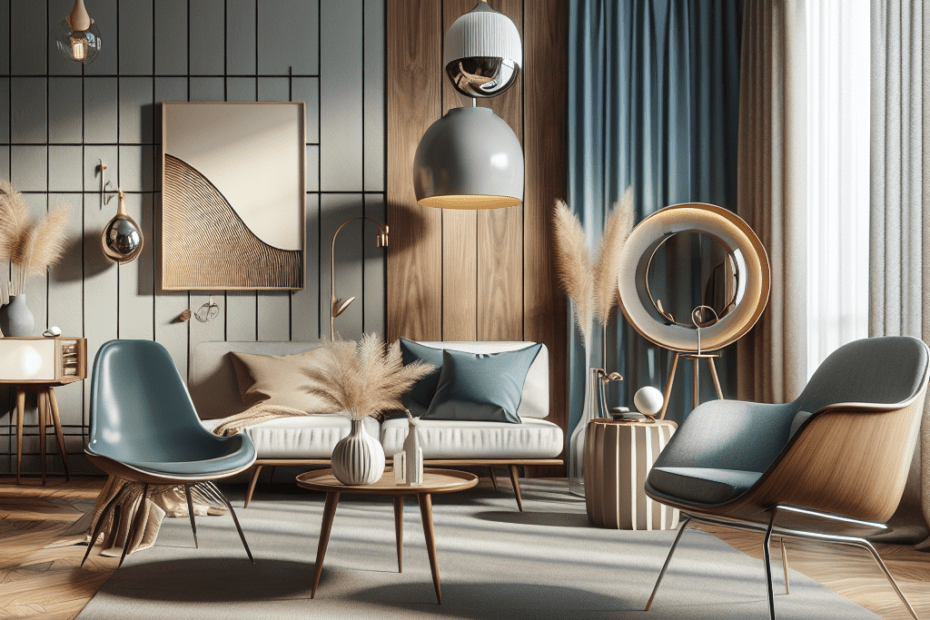“`html
Introduction to Mid-Century Modern Styling
In recent years, more people have embraced the charm and timeless appeal of mid-century modern design. Known for its clean lines, functional elegance, and the seamless blend of form and function, this design style has resurfaced powerfully. They want to transform their homes, making them stylish and nostalgic for the mid-20th century vibe. With the right guidance and a few key insights, anyone can infuse mid-century modern elements into their room styling. Here, they will find essential tips for mastering mid-century modern styling.
Understanding Mid-Century Modern Design
Mid-century modern design started in the mid-20th century, from the mid-1940s to the late 1960s. This design movement is characterized by simplicity, organic forms, and integration with nature. Today, it thrives because of its ability to harmonize functionality with aesthetics, as highlighted in data by Statista, showing that 30% of new homeowners opt for mid-century modern furniture for its timeless appeal.
Key Mid-Century Modern Styling Tips
- Embrace Minimalism: Mid-century modern design thrives on simplicity. They should focus on decluttering their space and choosing furniture pieces that have simple yet functional designs. This less-is-more approach makes rooms appear spacious and organized.
- Select Iconic Furniture: They can add signature pieces like the Eames Lounge Chair or a Noguchi coffee table to give their room an authentic mid-century modern feel. Such pieces serve as focal points within the room and echo the distinct lines and natural materials indicative of mid-century design.
- Choose the Right Color Palette: The color palette should include warm earthy tones like mustard, olive green, and burnt orange. White and gray hues act as a neutral background to allow the furniture to stand out.
- Integrate Natural Materials: Incorporating wood, leather, and metal adds warmth and texture. It’s advisable to use walnut wood, given its popularity for mid-century furniture, as supported by design studies.
- Don’t Forget the Lighting: Mid-century modern design treasures unique lighting fixtures. Pendant lights, arc floor lamps, or sputnik chandeliers not only provide function but also showcase creative form.
Room By Room Decorating Guide
| Room | Styling Tips |
|---|---|
| Living Room | Use a mix of textures with a statement piece of furniture. Opt for asymmetrical layouts to amplify visual interest. |
| Bedroom | Incorporate a platform bed and keep nightstands minimal. Use muted colors for a tranquil vibe. |
| Dining Room | Consider a walnut dining table paired with sleek, minimalist chairs. Use geometric patterns for tableware or curtains. |
| Office | Choose ergonomic furniture like the Eames Molded Plastic Chair. Utilize open shelving to keep the space functional and airy. |
The Importance of Balance and Proportion
Balance and proportion are core principles in mid-century modern styling. They should aim to create a sense of equilibrium using both furniture and decorative elements. For instance, if they have a large sofa as the centerpiece in the living room, balancing it with smaller side tables and chairs keeps the scale proportional. The idea is to maintain visual cohesion and comfort without overcrowding the space.
Incorporating Art and Accessories
Mid-century modern design celebrates art. They should consider including abstract art pieces that reflect the era’s ethos, whether it be through bold colors or geometric patterns. Accessories, such as vases or clocks with a retro flair, can subtly enhance the overall aesthetic without overpowering the space.
Key Takeaways
- Mid-century modern design is about form, function, and simplicity.
- Iconic furniture and a suitable color palette are essential.
- Natural materials and unique lighting play crucial roles.
- Balance and proportion help create a cohesive space.
- Art and small accessories complete the look.
FAQ
-
What is the hallmark of mid-century modern design?
The hallmark of mid-century modern design is its clean lines, minimalist silhouettes, and functional aesthetics, often using natural materials.
-
Can mid-century modern be mixed with other styles?
Yes, it can blend well with other styles like Scandinavian or industrial, provided they maintain harmony in elements like color and proportions.
-
Is mid-century modern still popular today?
Yes, its timeless appeal and adaptability make it a continued favorite among designers and homeowners.
-
What materials are essential for mid-century modern furniture?
Wood, particularly walnut, along with leather, metal, and glass, are frequently used materials in mid-century modern furniture.
-
How can lighting impact a mid-century modern room?
Lighting can enhance a room by serving both functional and decorative purposes. Unique fixtures like arc lamps or sputnik chandeliers are iconic elements.
“`
